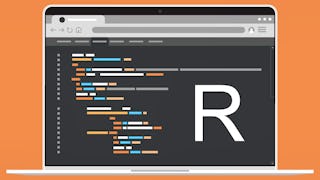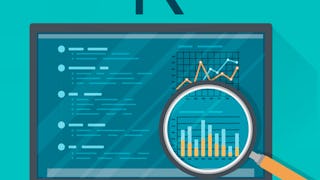Aktualisiert im Mai 2025. Dieser Kurs enthält jetzt Coursera Coach! Eine intelligentere Art zu lernen mit interaktiven Echtzeit-Unterhaltungen, die Ihnen helfen, Ihr Wissen zu testen, Annahmen zu hinterfragen und Ihr Verständnis zu vertiefen, während Sie im Kurs vorankommen. Dieser tiefgreifende Kurs führt Sie zunächst durch die Grundlagen der R-Programmierung, von der Einrichtung der Umgebung mit R und RStudio bis zum Verständnis der Benutzeroberfläche. In den ersten Abschnitten lernen Sie grundlegende Programmierkonzepte wie Datentypen, Funktionen und Vektoroperationen kennen, um sich eine solide Basis in R zu schaffen. Sie lernen auch den Umgang mit komplexen Strukturen wie Matrizen und Dataframes, die eine effiziente Organisation und Manipulation von Daten ermöglichen. Im weiteren Verlauf des Kurses lernen Sie fortgeschrittenere R-Funktionen kennen, wie das Erstellen und Ändern von Datenframes, die Verwendung des beliebten Pakets dplyr und die Arbeit mit relationalen, logischen Operatoren und Schleifen. Die Lektionen zur Datenmanipulation und -visualisierung bieten praktische Erfahrung in der Datenbereinigung und -präsentation und behandeln wichtige Werkzeuge wie ggplot2 zur Erstellung aufschlussreicher Grafiken und Diagramme. Diese Fähigkeiten werden Ihnen helfen, Daten zu analysieren und datengesteuerte Entscheidungen effektiver zu treffen. Schließlich wird der Kurs in die Statistik mit explorativer Datenanalyse, Hypothesentests und linearer Regressionsmodellierung eintauchen. Durch die Beherrschung dieser Techniken werden Sie in die Lage versetzt, reale Daten zu analysieren, sinnvolle Erkenntnisse zu gewinnen und Vorhersagen zu treffen. Egal, ob Sie ein angehender Datenwissenschaftler oder ein Statistiker sind, der seine Fähigkeiten verbessern möchte, dieser Kurs bietet alles, was Sie brauchen, um im Bereich der Datenwissenschaft mit R erfolgreich zu sein. Dieser Kurs richtet sich an angehende Datenwissenschaftler, Statistiker und Fachleute, die R für die Datenanalyse beherrschen möchten. Grundkenntnisse in der Programmierung sind von Vorteil, aber nicht erforderlich.

Genießen Sie unbegrenztes Wachstum mit einem Jahr Coursera Plus für 199 $ (regulär 399 $). Jetzt sparen.

R-Programmierung für Statistik und Datenwissenschaft

Dozent: Packt - Course Instructors
Bei enthalten
(10 Bewertungen)
Empfohlene Erfahrung
Was Sie lernen werden
Unterscheidung zwischen Datenstrukturen (Vektoren, Matrizen, Dataframes)
Durchführung von Hypothesentests und Interpretation der statistischen Ergebnisse
Bewertung der Eignung von Modellen der Linearen Regression
Visualisierung von Daten mit ggplot2 für eine aufschlussreiche Präsentation
Kompetenzen, die Sie erwerben
- Kategorie: Datenumwandlung
- Kategorie: Datenverarbeitung
- Kategorie: Wahrscheinlichkeit & Statistik
- Kategorie: Statistisches Programmieren
- Kategorie: Deskriptive Statistik
- Kategorie: Datenvisualisierung
- Kategorie: Datenstrukturen
- Kategorie: R-Programmierung
- Kategorie: Statistische Modellierung
- Kategorie: Ggplot2
- Kategorie: Datenmanipulation
- Kategorie: Datenanalyse
- Kategorie: Statistische Analyse
- Kategorie: Explorative Datenanalyse
- Kategorie: Tidyverse (R-Paket)
- Kategorie: Regressionsanalyse
- Kategorie: Grundsätze der Programmierung
Wichtige Details

Zu Ihrem LinkedIn-Profil hinzufügen
6 Aufgaben
Erfahren Sie, wie Mitarbeiter führender Unternehmen gefragte Kompetenzen erwerben.

In diesem Kurs gibt es 11 Module
In diesem Modul werden wir die grundlegenden Schritte erkunden, die für die Verwendung von R und RStudio für die statistische Analyse und Datenwissenschaft erforderlich sind. Sie lernen, wie Sie die notwendige Software installieren und konfigurieren, sich mit der Schnittstelle von RStudio vertraut machen und das Erscheinungsbild an Ihre Vorlieben anpassen. Außerdem erfahren Sie, wie Sie wichtige Pakete installieren und verwalten, um die Funktionalität von R zu erweitern.
Das ist alles enthalten
6 Videos1 Lektüre
In diesem Modul tauchen wir in die grundlegenden Elemente ein, die die R-Programmierung ausmachen. Sie lernen, wie Sie verschiedene Datentypen wie Ganzzahlen, Doppelzahlen, Zeichen und logische Werte erstellen und mit ihnen arbeiten können. Wir erforschen, wie Funktionen funktionieren, wie Sie Ihre eigenen Funktionen erstellen können und wie sich Koerzitionsregeln auf Datentypen auswirken. Außerdem werden wir die Verwendung des Skript-Editors mit der Konsole vergleichen, um effizienter zu programmieren.
Das ist alles enthalten
8 Videos
In diesem Modul konzentrieren wir uns auf Vektoren, eine der grundlegenden Datenstrukturen in R. Sie lernen, wie Vektoren erstellt und manipuliert werden, erfahren etwas über das Recycling von Vektoren und entdecken, wie man Vektoren zur besseren Übersichtlichkeit benennt. Wir werden auch Techniken für das Slicing und die Indizierung von Vektoren behandeln und untersuchen, wie man die Dimensionen von Objekten an die eigenen Datenbedürfnisse anpasst. Darüber hinaus werden Sie mit den Merkmalen der R-Hilfe vertraut gemacht, um Fehler zu beheben und Ihr Wissen zu erweitern.
Das ist alles enthalten
7 Videos1 Aufgabe
In diesem Modul befassen wir uns mit Matrizen, einer weiteren wichtigen Datenstruktur in R. Sie werden lernen, wie man Matrizen sowohl traditionell als auch mit einzeiligen Befehlen effizient erstellt. Wir werden uns mit dem Recycling von Matrizen, der Indizierung bestimmter Elemente und mit Techniken zum Zerlegen von Matrizen beschäftigen, um Teilmengen von Daten abzurufen. Darüber hinaus führen Sie Matrix-Arithmetik und -Operationen durch und erkunden verwandte Themen wie den Umgang mit kategorialen Daten, die Erstellung von Faktoren und die Arbeit mit Listen in R für ein komplexeres Datenmanagement.
Das ist alles enthalten
10 Videos
In diesem Modul werden wir die grundlegenden Programmierkonzepte behandeln, die es Ihnen ermöglichen, effizienten und flexiblen R Code zu schreiben. Sie lernen, wie Sie relationale und logische Operatoren verwenden, mit Vektoren in logischen Operationen arbeiten und den Programmfluss mit if-, else- und else if-Anweisungen steuern. Wir werden auch Schleifen - wie for, while und repeat - erkunden und tiefer in die Funktionserstellung eintauchen, wobei wir Überlegungen zum Scoping und zu bewährten Verfahren anstellen. Diese Konzepte sind entscheidend für die Automatisierung von Aufgaben und die Strukturierung komplexerer R-Programme.
Das ist alles enthalten
10 Videos
In diesem Modul befassen wir uns mit Dataframes, einer wichtigen Datenstruktur für den Umgang mit tabellarischen Daten in R. Sie lernen, wie Sie Dataframes erstellen, das Tidyverse-Paket zur Rationalisierung der Datenmanipulation verwenden und Datensätze effizient importieren/exportieren. Wir behandeln Schlüsseltechniken wie Indizierung, Slicing und die Erweiterung von Dataframes sowie Strategien zur Verwaltung fehlender Daten. Diese Fähigkeiten werden Sie in die Lage versetzen, effektiv mit realen Datensätzen in R zu arbeiten.
Das ist alles enthalten
10 Videos1 Aufgabe
In diesem Modul konzentrieren wir uns auf grundlegende Datenmanipulationstechniken, die es Ihnen ermöglichen, effizient mit großen Datensätzen in R zu arbeiten. Sie werden das dplyr-Paket für die Datenumwandlung, einschließlich Filtern, Mutieren und Zusammenfassen von Daten, kennenlernen. Außerdem lernen Sie, wie Sie Stichproben von Daten nehmen und den Pipe Operator für die nahtlose Verkettung von Befehlen nutzen können. Schließlich lernen Sie, Datensätze mit Funktionen wie gather, separate, unite und spread zu bereinigen und Daten für die Analyse in einem strukturierten und sauberen Format vorzubereiten.
Das ist alles enthalten
7 Videos
In diesem Modul werden wir das leistungsstarke ggplot2-Paket zur Erstellung verschiedener Arten von Datenvisualisierungen in R erkunden. Sie werden lernen, wie Sie Histogramme, Balkendiagramme, Box-Plots und Streudiagramme zur visuellen Interpretation Ihrer Daten erstellen. Wir werden auch die Rolle von Variablen überdenken und wie sie in grafischen Formaten dargestellt werden können. Diese Visualisierungen werden Ihnen helfen, Trends, Muster und Erkenntnisse aufzudecken, die in der Statistik und Datenwissenschaft von entscheidender Bedeutung sind.
Das ist alles enthalten
8 Videos
In diesem Modul werden Schlüsselkonzepte der Explorativen Datenanalyse (EDA) behandelt, die helfen, die Struktur von Daten zusammenzufassen und zu verstehen. Sie lernen die Unterschiede zwischen Populationen und Stichproben kennen, berechnen Maße für die zentrale Tendenz und untersuchen die Verteilung der Daten anhand der Schiefe. Wir werden auch in die Maße der Variabilität wie Abweichung, Standardabweichung und Variationskoeffizient eintauchen und mit einer Einführung in Kovarianz und Korrelation zur Identifizierung von Beziehungen zwischen Variablen abschließen.
Das ist alles enthalten
5 Videos1 Aufgabe
In diesem Modul werden wir die grundlegenden Konzepte der Hypothesentests in der statistischen Analyse untersuchen. Sie erfahren etwas über verschiedene Verteilungen, die Bedeutung des Standardfehlers und wie man Konfidenzintervalle berechnet und interpretiert. Außerdem werden wir uns mit der Durchführung von Hypothesentests, der Rolle von p-Werten und dem Unterschied zwischen Tests bei bekannter und unbekannter Abweichung der Population beschäftigen. Darüber hinaus werden Sie zwei Mittelwerte in Szenarien mit abhängigen und unabhängigen Stichproben vergleichen und dabei mögliche Fehler verstehen, die bei Hypothesentests auftreten können.
Das ist alles enthalten
9 Videos
In diesem Modul werden wir uns mit den Grundlagen der Linearen Regressionsanalyse beschäftigen. Sie lernen das Modell der linearen Regression kennen, wie es mit der Korrelation verglichen wird und wie es geometrisch dargestellt werden kann. Wir führen Sie durch die Durchführung Ihrer ersten Regression in R, die Interpretation der Regressionstabelle und das Verständnis der Zerlegung der Variabilität mit SST, SSR und SSE. Außerdem lernen Sie die Bedeutung von R-Quadrat kennen und erfahren, wie es die Erklärungskraft des Modells widerspiegelt. Diese Konzepte sind entscheidend für das Verständnis von Beziehungen in Daten.
Das ist alles enthalten
7 Videos3 Aufgaben
Dozent

von
Mehr von Datenanalyse entdecken
 Status: Kostenloser Testzeitraum
Status: Kostenloser Testzeitraum Status: Kostenloser Testzeitraum
Status: Kostenloser TestzeitraumJohns Hopkins University
 Status: Kostenloser Testzeitraum
Status: Kostenloser Testzeitraum Status: Kostenloser Testzeitraum
Status: Kostenloser TestzeitraumJohns Hopkins University
Warum entscheiden sich Menschen für Coursera für ihre Karriere?




Bewertungen von Lernenden
10 Bewertungen
- 5 stars
60 %
- 4 stars
30 %
- 3 stars
0 %
- 2 stars
10 %
- 1 star
0 %
Zeigt 3 von 10 an
Geprüft am 19. Mai 2025
The lessons are superbly arranged that makes them easy to understand
Geprüft am 19. Juli 2025
its very god course and and amazing enjoyable and understandable recommended to all of you,.
Geprüft am 20. Juli 2025
Thank you for such a comprehensive, practical, and super-enjoyable course. Good luck!
Häufig gestellte Fragen
Ja, Sie können das erste Video in der Vorschau ansehen und den Lehrplan einsehen, bevor Sie sich anmelden. Sie müssen den Kurs kaufen, um auf Inhalte zuzugreifen, die nicht in der Vorschau enthalten sind.
Wenn Sie sich vor dem Beginn der Sitzung in den Kurs einschreiben, haben Sie Zugang zu allen Vorlesungsvideos und Lesestoff für den Kurs. Sobald die Sitzung beginnt, können Sie die Aufgaben einreichen.
Sobald Sie sich angemeldet haben und Ihre Sitzung beginnt, haben Sie Zugang zu allen Videos und anderen Ressourcen, einschließlich der Lektüre und dem Diskussionsforum des Kurses. Sie können Übungsaufgaben ansehen und einreichen und die erforderlichen benoteten Aufgaben erledigen, um eine Note und ein Kurszertifikat zu erhalten.
Weitere Fragen
Finanzielle Unterstützung verfügbar,





